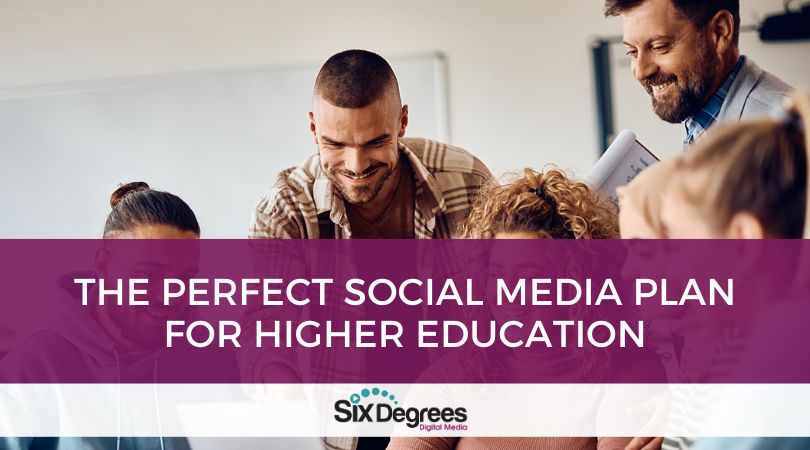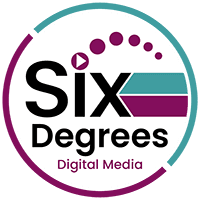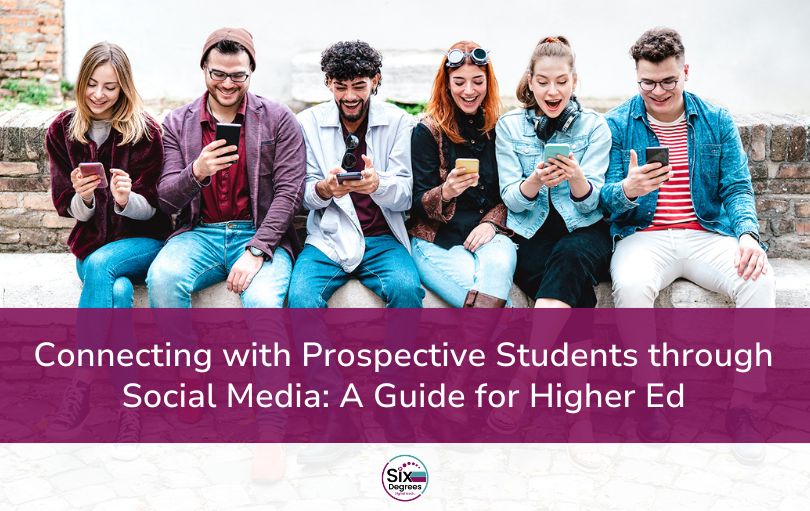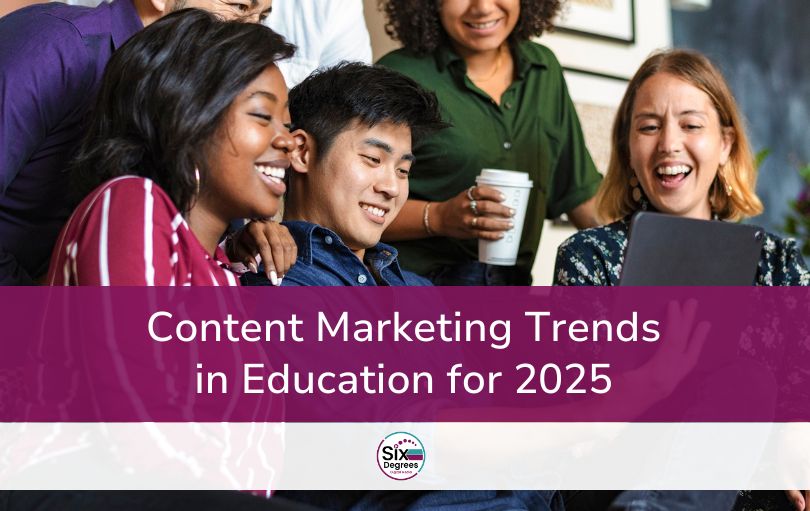
Social media platforms have become essential tools for higher education institutions to engage with their target audience, strengthen their brand, and showcase their unique offerings. A strategic social media presence can open doors to building relationships with prospective students, fostering a sense of community among current students, and maintaining strong connections with alumni.
Higher education marketing professionals can use the tools and knowledge in this guide to craft the perfect social media plan. Through a combination of goal-setting, platform selection, content creation, and audience engagement, institutions can maximize the potential of social media to achieve their marketing objectives.
We will delve into the importance of video content, as it has emerged as a powerful and engaging medium for storytelling and information sharing. Offering value to your audience is crucial, and having a variety of content types will cater to the needs and interests of prospective students, current students, and alumni. Finally, we will discuss common mistakes to avoid in social media management to ensure a strong, consistent, and engaging online presence.
By the end of this guide, you will have a clear understanding of the vital components of a successful social media plan for higher education and be well-equipped to create and implement your institution’s winning social media strategy. Let’s dive in and unlock the immense potential of social media for higher education marketing.
Setting Social Media Goals and Objectives: The Roadmap to Success
Establishing clear goals and objectives for your social media plan ensures that your institution’s efforts bring results that are aligned with your overarching mission. It also enables you to measure success and make data-informed decisions to optimize your approach over time.
For example:
- By setting a goal to increase enrollment by 10% within the next academic year, a university can develop targeted social media campaigns that showcase its academic programs, campus life, and student success stories. These campaigns can directly address the concerns of prospective students and influence their decision-making process.
- An objective to enhance brand visibility may prompt a college to collaborate with popular influencers in the education sphere, leveraging their reach to showcase the college’s unique offerings to a wider audience. This could lead to increased recognition and a more robust online reputation.
- A community college looking to foster a sense of community among its students might utilize social media to create interactive content, such as polls and discussion threads, encouraging students to share their experiences and engage with their peers. This can result in a more connected student body and a stronger support network for academic success.
When it comes to setting social media goals, consider the following key areas for higher education institutions:
- Increasing Enrollment: Showcase the unique advantages of attending your institution by promoting academic programs, sharing success stories, and offering virtual campus tours.
- Enhancing Brand Visibility: Increase brand awareness and position your institution as a thought leader in higher education. Share relevant news, research breakthroughs, and faculty achievements to emphasize your institution’s commitment to excellence.
- Fostering Community: Start conversations and interactions among students, faculty, staff, and alumni. Encourage engagement through user-generated content and interactive events.
- Supporting Alumni Engagement: Maintain strong relationships with alumni by sharing news about alumni successes, offering career resources, and promoting networking opportunities.
Once you have identified your goals and objectives, it’s essential to establish key performance indicators (KPIs) that allow you to measure the success of your social media efforts.
Important KPIs for your social media campaign:
- Follower growth
- Engagement rate
- Conversion rate
- Sentiment analysis
By consistently tracking these metrics, you can gauge the effectiveness of your social media plan, identify areas for improvement, and make data-driven decisions to refine your approach. Ultimately, setting clear goals and objectives, combined with diligent measurement and analysis, will empower your institution to harness the full potential of social media in higher education marketing.
Choosing the Right Social Media Platforms: Navigating the Digital Landscape
There are so many social media platforms available, so it’s crucial to select the ones that best align with your higher education institution’s target audience. Each platform has its unique features and user demographics, which can be leveraged to connect with the right people.
Higher education institutions can benefit from Facebook’s extensive user base and community-building tools to connect with prospective students, engage current students, and maintain relationships with alumni. A university can create a Facebook Group for incoming freshmen to facilitate connections before the academic year begins, providing them with a supportive community and easing their transition to campus life.
Instagram’s predominantly younger user base makes it an ideal platform for reaching prospective students and showcasing the vibrant campus life that awaits them.
It’s a powerful platform for showcasing your institution’s campus, events, and accomplishments through images and short videos. With features like Instagram Stories and Reels, institutions can share a diverse range of content to engage their audience.
YouTube
From informational videos about academic programs to virtual campus tours, YouTube can be an invaluable tool for connecting with prospective students and showcasing your institution’s unique offerings. For instance, you can create a YouTube series featuring interviews with successful alumni, providing inspiration, and demonstrating the real-world value of their education.
This fast-paced platform is ideal for sharing news, updates, and engaging in real-time conversations with your audience. For instance, you can live-tweet during an open house event, providing real-time updates, sharing highlights, and engaging with prospective students, even if they are unable to attend in person.
As a professional networking platform, LinkedIn is particularly valuable for engaging with alumni and showcasing your institution’s career resources, research, and faculty achievements. Establishing a strong presence on LinkedIn can help position your institution as a leader in higher education and foster connections that can lead to valuable partnerships and collaborations.
By sharing alumni success stories and career resources, you can demonstrate your commitment to post-graduate success and attract career-minded students.
When selecting the most suitable platforms for your institution, consider your target audience, the type of content you plan to create, and the resources available for content production and management.
Ensure a consistent and cohesive brand presence by:
- Developing a unified visual identity, including logos, colors, and typography.
- Aligning your messaging and tone across all platforms to convey a consistent brand personality.
- Encouraging your audience to follow your institution on multiple platforms.
By carefully selecting the right social media platforms and maintaining a consistent brand presence, your higher education institution can effectively engage with its audience and achieve its marketing goals.
The Importance of Video in Social Media Strategy: Engaging Audiences in the Digital Age
In the ever-evolving landscape of social media, video content has emerged as a powerful tool to capture audience attention and foster deep engagement. For higher education institutions, leveraging video in their social media strategy can help them connect with their audience in dynamic, impactful ways, and present their offerings in a compelling, accessible format.
Types of Video Content:
- Live Streams: Perfect for virtual tours, live Q&A sessions, or broadcasting special events.
- Promotional Videos: Highlight the unique aspects of your institution, such as academic programs, faculty expertise, or campus facilities.
- Educational Content: Webinars, tutorials, and lectures provide value to your audience and showcase your institution’s commitment to learning.
- Testimonials and Success Stories: Sharing stories from successful alumni can build trust and demonstrate the real-world value of your programs.
- User-Generated Content: Encourage your students to create and share videos about their experiences at your institution.
Tips for Creating Engaging Video Content:
- Know Your Audience
- Use Memorable Storytelling
- Produce High Quality Content
- Include a Clear Call to Action
- Optimize for Each Platform
By crafting compelling, targeted video content, you can reach your audience on a deeper level, providing them with valuable insights into your institution and fostering a strong sense of connection and engagement.
Creating and Sharing Valuable Content: Winning Hearts and Minds on Social Media
Offering valuable content is at the heart of a successful social media strategy. As a higher education institution, your audience seeks more than just promotional material. They crave insights into your community, unique viewpoints from your experts, and content that resonates with their interests and aspirations. By consistently delivering valuable content, you not only foster deep engagement with your audience but also position your institution as a trusted and credible source of information.
Informative Articles
Sharing articles or blog posts on relevant topics can provide huge value to your audience.
Expert Interviews
Leverage the expertise within your institution. Conduct interviews with faculty members, alumni, or guest speakers, and share their insights on topical issues or industry trends. Expert interviews not only provide valuable knowledge to your audience but also showcase the caliber of thought leaders associated with your institution.
Behind-the-Scenes Looks
Offer your audience a glimpse into the day-to-day life at your institution. This could include campus events, student activities, or even a day in the life of a faculty member. You could share a behind-the-scenes look at the preparation for a major campus event, providing a sense of anticipation and inviting the audience to participate, either in-person or virtually.
Webinars and Online Workshops
Offer free online learning opportunities on topics relevant to your audience. These can be a powerful demonstration of your institution’s commitment to education and community service. A series of webinars on career development could provide value to both current students and alumni.
Here are just a few examples of great content:
- Tips for doing well at college interviews
- In-depth explorations of innovative research conducted at your institution
- Study tips
- Time management strategies
Guidance on Developing a Content Calendar
A content calendar is a crucial tool for planning, organizing, and scheduling your social media content. It ensures that you consistently share high-quality content and allows you to plan for key dates and events. Here are some steps to develop an effective content calendar:
- Identify Key Dates: Start by identifying key dates relevant to your institution, such as application deadlines, open house events, alumni weekends, etc.
- Define Content Themes: Identify a few broad themes that your content will revolve around. This could be guided by your institution’s goals, audience interests, or key events in your academic calendar.
- Plan Your Content: For each key date or theme, plan out the specific content you want to share. Ensure you have a mix of content types to keep your audience engaged.
- Schedule Your Content: Decide when each piece of content will be shared, taking into consideration the optimal times for posting on each platform.
- Review and Adjust: Regularly review your content calendar and adjust as necessary. Be flexible and ready to respond to timely events or trending topics.
By creating and sharing valuable content, you can make your institution’s social media channels a rich source of information and engagement for your audience. This not only enhances your institution’s online presence but also builds strong, meaningful relationships with your community.
Engaging with Your Audience: The Power of Genuine Connection
The beauty of social media lies in its capacity to break down barriers and foster direct, genuine interaction. For higher education institutions, this means not just broadcasting content, but also actively engaging with your audience. Genuine engagement helps to build a vibrant online community around your institution, enhances your brand’s credibility, and provides valuable insights into your audience’s interests and concerns.
Responding to Comments and Messages
Active and thoughtful engagement with your audience shows that you value their opinions and care about their experiences. Respond promptly to comments and direct messages, acknowledging their input and providing helpful responses.
If a prospective student comments on a post asking about admission requirements, a timely and detailed response not only helps that individual, but also shows your wider audience that you are active and responsive.
Creating Interactive Content
Interactive content such as polls, quizzes, or Q&A sessions can stimulate engagement and provide a fun, engaging way for your audience to interact with your institution.
You might use a poll to let your audience vote on the theme for the next campus event. This not only boosts engagement but also gives the audience a sense of ownership and involvement in campus activities.
Cultivating a Sense of Community
Engage in conversations, acknowledge milestones, celebrate achievements, and show appreciation for your audience’s input. By doing so, you foster a sense of community that can turn casual followers into loyal advocates for your institution.
Tip: Highlighting a student’s achievement in a social media post not only celebrates that individual’s success but also motivates other students and reinforces a culture of achievement.
Common Mistakes to Avoid in Higher Education Social Media: Navigating Digital Pitfalls
As powerful as social media can be for higher education institutions, certain common mistakes can undermine your efforts and impede your digital growth. Recognizing these pitfalls and knowing how to avoid them is key to maintaining a robust, effective social media presence.
Inconsistency
Regular, consistent posting is crucial in keeping your audience engaged and your institution visible. Irregular or sparse posting can lead to your content being overlooked and your audience’s interest waning.
Neglecting Engagement
Social media is not a one-way street. Simply posting content without engaging with your audience can create a sense of disconnect and missed opportunities to build relationships.
Overly Promotional Content
While it’s important to highlight your institution’s offerings, too much self-promotion can alienate your audience. Social media users seek value and engagement, not constant sales pitches.
Ignoring Negative Feedback
Negative comments or reviews can be challenging but ignoring them can harm your reputation. It’s crucial to handle negative feedback professionally and proactively.
Lack of a Defined Strategy
Without a clear social media strategy, your efforts can become disjointed and ineffective. This can result in a confusing brand image and missed opportunities to reach your goals.
Failing to Adapt
Social media trends evolve rapidly. Sticking rigidly to old tactics without adapting to new trends can result in your content becoming outdated and less engaging.
By avoiding these common mistakes, higher education institutions can effectively leverage social media to connect with their audience, enhance their brand visibility, and achieve their strategic objectives. With careful planning, active engagement, and a commitment to providing value, your social media channels can become a powerful tool for growth and community building.
Leveraging Social Media for Growth and Engagement in Higher Education
In the digital age, social media has become an indispensable tool for higher education institutions. It offers a dynamic platform for engaging with your audience, enhancing your institution’s visibility, and achieving strategic goals. Throughout this guide, we’ve explored several key components of an effective social media plan and how they can be tailored to the unique needs and objectives of higher education institutions.
As we’ve seen, social media offers immense opportunities for higher education institutions. It is a platform where you can showcase your institution’s strengths, engage directly with your audience, and build a community that extends beyond the physical boundaries of your campus.
We encourage you to take advantage of these opportunities.
- Set defined goals
- Choose your platforms
- Craft valuable content
- Track and adapt
So, start implementing these strategies today, and let the power of social media propel your institution towards greater growth and engagement.
Schedule a strategy session with us today to see how to improve your social media efforts.











